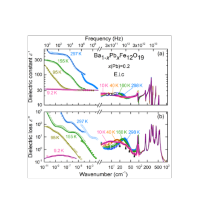Abstract
Due to their outstanding dielectric and magnetic properties, hexaferrites are attracting ever-increasing attention for developing electronic components of next-generation communication systems. The complex crystal structure of hexaferrites and the critical dependences of their electric and magnetic properties on external factors, such as magnetic/electric fields, pressure, and doping, open ample opportunities for targeted tuning of these properties when designing specific devices. Here we explored the electromagnetic properties of lead-substituted barium hexaferrite, Ba1−xPbxFe12O19, a compound featuring an extremely rich set of physical phenomena that are inherent in the dielectric and magnetic subsystems and can have a significant effect on its electromagnetic response at terahertz frequencies. We performed the first detailed measurements of the temperature-dependent (5–300 K) dielectric response of single-crystalline Ba1−xPbxFe12O19 in an extremely broad spectral range of 1 Hz–240 THz. We fully analyzed numerous phenomena with a corresponding wide distribution of specific energies that can affect the terahertz properties of the material. The most important fundamental finding is the observation of a ferroelectric-like terahertz excitation with an unusual temperature behavior of its frequency and strength. We suggest microscopic models that explain the origin of the excitation and its nonstandard temperature evolution. Several narrower terahertz excitations are associated with electronic transitions between the fine-structure components of the Fe2+ ground state. The discovered radio-frequency relaxations are attributed to the response of magnetic domains. Gigahertz resonances are presumably of magnetoelectric origin. The obtained data on diverse electromagnetic properties of Ba1−xPbxFe12O19 compounds provide information that makes the entire class of hexaferrites attractive for manufacturing electronic devices for the terahertz range.
Article in Nature NPGAsia: Lead-substituted barium hexaferrite for tunable terahertz optoelectronics


